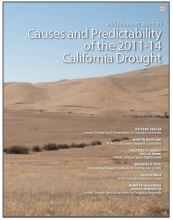Causes and Predictability of the 2011-14 California Drought

The causes and predictability of the California drought during the three consecutive rainy seasons (November-April) 2011/12 to 2013/14 are analyzed using observations and ensembles of simulations conducted with seven atmosphere models forced by observed sea surface temperatures (SSTs). Historically, dry California winters have most commonly been associated with a ridge off the west coast, part of a mid-latitude wave train having no obvious SST forcing. Wet winters have most commonly been associated with a trough off the west coast and an El Niño event. These attributes of dry and wet winters are captured by many of the models used in the current assessment. According to the models, up to a third of California winter precipitation variance can be explained in terms of SST forcing, with the majority explained by internal atmospheric variability. Nonetheless. SST-forcing was key to sustaining a ridge of high pressure over the west coast during each of the last three winters, and may have explained nearly one-third the CA precipitation deficits during the recent drought. In 2011/12 the forced component was a response to a La Niña event whereas in 2012/13 and 2013/14 it was related to a warm tropical west Pacific SST anomaly. All models contain a mode of climate variability that links west Pacific SST anomalies to a northeastward propagating wave train with a ridge off the North American west coast as part of its SST sensitivity during at least the last 35 years. This mode explains less variance than ENSO and Pacific decadal variability and its importance in 2012/13 and 2013/14 was unusual. The CMIP5 models project that rising greenhouse gases should increase California winter precipitation but that changes to date are small compared to the recent drought anomalies. As such, the recent drought was dominated by natural variability, a conclusion framed by a discussion of the differences between observed and modeled tropical SST trends over the past decades.
Seager, R., M. Hoerling, S. Schubert, H. Wang, B. Lyon, A. Kumar, J. Nakamura, and N. Henderson. 2014. Causes and Predictability of the 2011-14 California Drought. Page 42. National Oceanographic and Atmospheric Administration.
